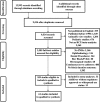Local Anesthetic Peripheral Nerve Block Adjuvants for Prolongation of Analgesia: A Systematic Qualitative Review
- PMID: 26355598
- PMCID: PMC4565585
- DOI: 10.1371/journal.pone.0137312
Local Anesthetic Peripheral Nerve Block Adjuvants for Prolongation of Analgesia: A Systematic Qualitative Review
Abstract
Background: The use of peripheral nerve blocks for anesthesia and postoperative analgesia has increased significantly in recent years. Adjuvants are frequently added to local anesthetics to prolong analgesia following peripheral nerve blockade. Numerous randomized controlled trials and meta-analyses have examined the pros and cons of the use of various individual adjuvants.
Objectives: To systematically review adjuvant-related randomized controlled trials and meta-analyses and provide clinical recommendations for the use of adjuvants in peripheral nerve blocks.
Methods: Randomized controlled trials and meta-analyses that were published between 1990 and 2014 were included in the initial bibliographic search, which was conducted using Medline/PubMed, Cochrane Central Register of Controlled Trials, and EMBASE. Only studies that were published in English and listed block analgesic duration as an outcome were included. Trials that had already been published in the identified meta-analyses and included adjuvants not in widespread use and published without an Investigational New Drug application or equivalent status were excluded.
Results: Sixty one novel clinical trials and meta-analyses were identified and included in this review. The clinical trials reported analgesic duration data for the following adjuvants: buprenorphine (6), morphine (6), fentanyl (10), epinephrine (3), clonidine (7), dexmedetomidine (7), dexamethasone (7), tramadol (8), and magnesium (4). Studies of perineural buprenorphine, clonidine, dexamethasone, dexmedetomidine, and magnesium most consistently demonstrated prolongation of peripheral nerve blocks.
Conclusions: Buprenorphine, clonidine, dexamethasone, magnesium, and dexmedetomidine are promising agents for use in prolongation of local anesthetic peripheral nerve blocks, and further studies of safety and efficacy are merited. However, caution is recommended with use of any perineural adjuvant, as none have Food and Drug Administration approval, and concerns for side effects and potential toxicity persist.
Conflict of interest statement
Figures
Similar articles
-
Research Status of Different Adjuvants on Nerve Block's Effect.Pain Physician. 2024 Nov;27(8):507-519. Pain Physician. 2024. PMID: 39621975 Review.
-
Additives to local anesthetics for peripheral nerve blocks: Evidence, limitations, and recommendations.Am J Health Syst Pharm. 2014 Mar 1;71(5):373-85. doi: 10.2146/ajhp130336. Am J Health Syst Pharm. 2014. PMID: 24534592 Review.
-
Neurotoxicity of common peripheral nerve block adjuvants.Curr Opin Anaesthesiol. 2015 Oct;28(5):598-604. doi: 10.1097/ACO.0000000000000222. Curr Opin Anaesthesiol. 2015. PMID: 26207854 Free PMC article. Review.
-
Review of benefits and adverse effects of the most commonly used local anesthetic adjuvants in peripheral nerve blocks.J Physiol Pharmacol. 2022 Jun;73(3). doi: 10.26402/jpp.2022.3.02. Epub 2022 Oct 22. J Physiol Pharmacol. 2022. PMID: 36302530 Review.
-
Efficacy and safety of buprenorphine in peripheral nerve blocks: A meta-analysis of randomised controlled trials.Eur J Anaesthesiol. 2017 Sep;34(9):576-586. doi: 10.1097/EJA.0000000000000628. Eur J Anaesthesiol. 2017. PMID: 28763315
Cited by
-
Effect of dexmedetomidine-assisted ultrasound-guided lower extremity nerve block on postoperative cognitive function in elderly patients undergoing hip surgery.Am J Transl Res. 2022 Nov 15;14(11):7977-7984. eCollection 2022. Am J Transl Res. 2022. PMID: 36505284 Free PMC article.
-
Glucocorticoid minimizes local anesthetic infusion requirement through adductor canal block and improves perioperative prosthetic joint range of motion in total knee arthroplasty.PLoS One. 2022 Jan 26;17(1):e0261949. doi: 10.1371/journal.pone.0261949. eCollection 2022. PLoS One. 2022. PMID: 35081134 Free PMC article.
-
The Study of Ropivacaine Pharmacokinetics in a Clinical Setting: A Critical Scoping Review from the Perspective of Analytical Methodologies.Int J Mol Sci. 2024 Dec 16;25(24):13487. doi: 10.3390/ijms252413487. Int J Mol Sci. 2024. PMID: 39769250 Free PMC article.
-
Nonopioid Drugs for Postoperative Pain: A Selection Governed by Choices of the Authors of Academic Articles.Curr Rev Clin Exp Pharmacol. 2025;20(2):158-167. doi: 10.2174/0127724328327509240919102209. Curr Rev Clin Exp Pharmacol. 2025. PMID: 40326266 Free PMC article. Review.
-
Does local anesthetic temperature affect the onset and duration of ultrasound-guided infraclavicular brachial plexus nerve block?: a randomized clinical trial.Braz J Anesthesiol. 2021 Jul-Aug;71(4):376-380. doi: 10.1016/j.bjane.2021.02.044. Epub 2021 Apr 3. Braz J Anesthesiol. 2021. PMID: 33823208 Free PMC article. Clinical Trial.
References
Publication types
MeSH terms
Substances
LinkOut - more resources
Full Text Sources
Other Literature Sources
Medical
Miscellaneous



